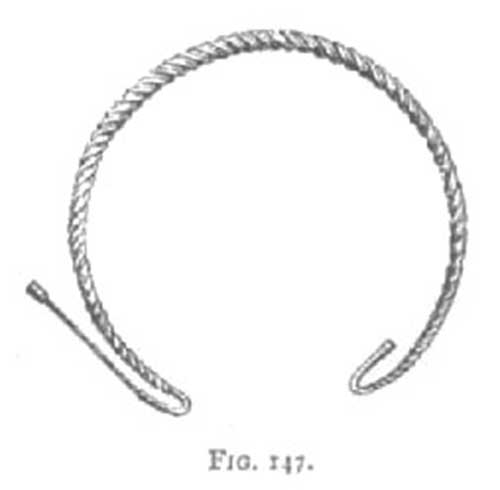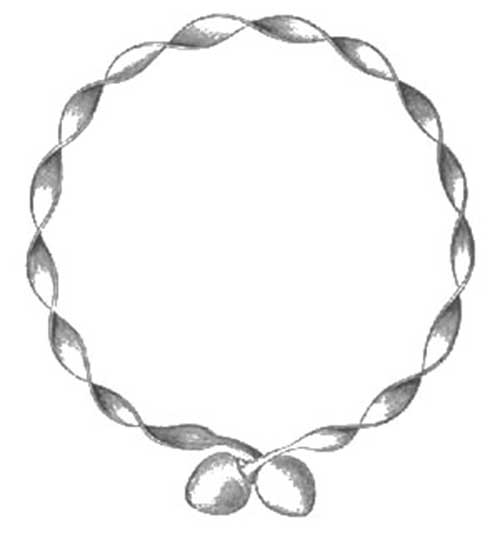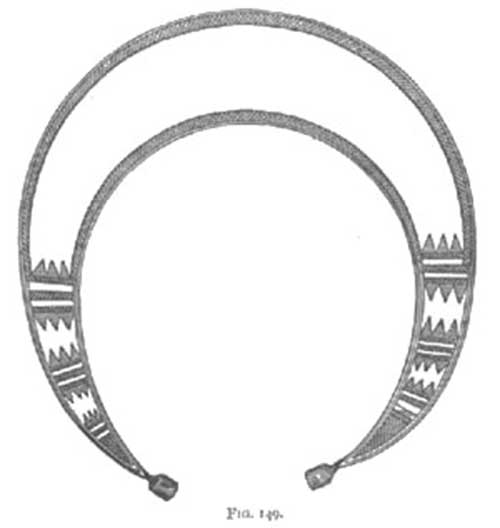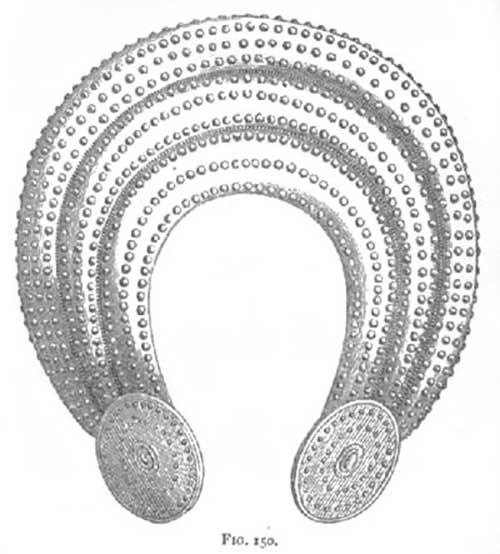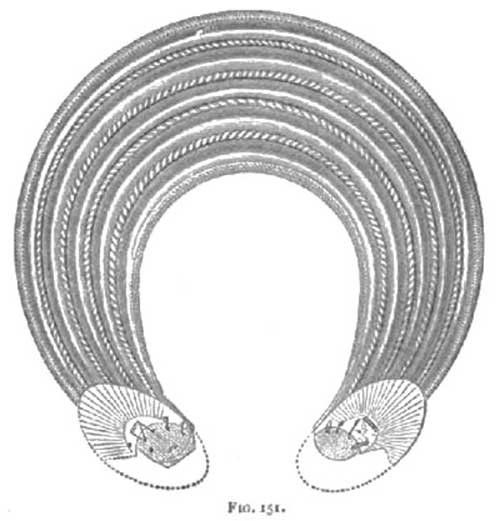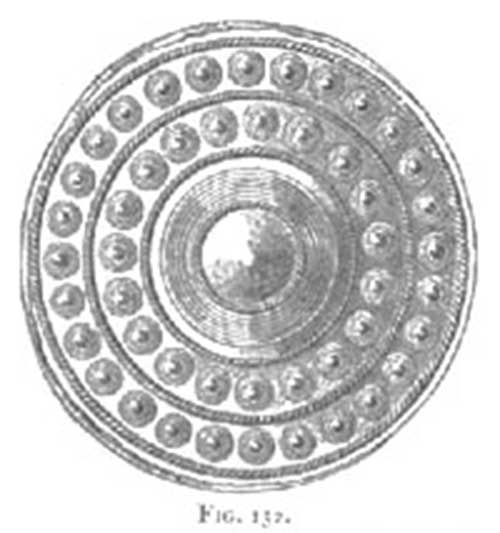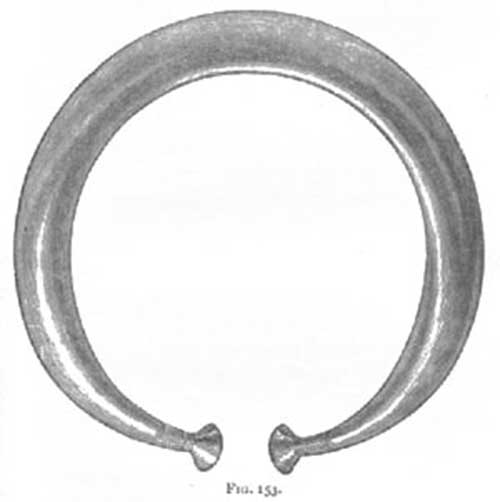Torques, Muntorcs, Gorgets and Necklaces in Ancient Ireland
From A Smaller Social History of Ancient Ireland 1906
« previous page | contents | start of chapter | next page »
CHAPTER XVIII....continued
Torques or Muntorcs.—Besides the necklaces properly so called, there were various kinds of gold and silver ornaments for wearing round the neck, of which perhaps the best known was the torque, which is repeatedly mentioned in our literature under the names torc and muntorc. The torque was often formed of a single straight bar of gold, square or triangular, from which the metal had been hollowed out along the flat sides, so as to leave four, or three, ribbons along the corners, after which it was twisted into a spiral, something like a screw with four, or three, threads: and the whole bar bended into a circular shape. But they were formed in other ways, as may be seen by an inspection of those in the National Museum in Dublin. There are in this Museum many muntorcs of various shapes and sizes. Some are barely the size of the neck, while others are so large that when worn they extended over the breast almost to the shoulders: and there are all intermediate sizes. One of the largest, found at Tara in the year 1810, is represented here (fig. 147).
FIG. 147. Gold Torque in National Museum: 15½ inches in diameter: found in 1810 in a mound at Tara. (From Petrie's Tara).
The one represented in fig. 148 is of unusual make, being formed by twisting a single plate of gold, and having two apples or balls of gold at the ends. The custom of; wearing torques, as well as rings and bracelets, was in ancient times very general, not only among the Irish, but among the northern nations, both of Europe and Asia, especially the Gauls, as all who have read Roman history will remember.
FIG. 148. Gold Torque, now in National Museum: found near Clonmacnoise. (From Wilde's Catalogue).
Crescents, Gorgets, or Necklets.—The word muince [moon-ke] denotes a neck-circlet, from muin, the neck. It was used in several different applications; but the necklets that we find constantly mentioned in the ancient tales by the name muince are to be generally understood as golden gorgets or collars for the neck, worn by both men and women, now often conveniently called "crescents." These golden crescents are of three main types. The FIRST is quite flat, thin, and brightly burnished.
FIG. 149. Gold Crescent of the first type, one continuous bright plate. 7 inches in outside diameter: weight, 18 dwts. In National Museum. (From W ilde's Catalogue).
Most of those of this kind are ornamented in delicate line patterns, which were produced by fine chisel-edged punches. Crescents of this kind are often called by the name lunula or lunette. Fig. 149 represents one of those beautiful objects, of which there are now more than thirty in the National Museum.
The SECOND type, and by far the most elaborate, is dish-shaped in general make, convex on one side, concave on the other: covered all over with ornamental designs.
FIG. 150. Gold Muince Crescent or Gorget of second type: the largest and most beautiful of this kind in the collection. Diameter 11 inches: weight 16 1/2 oz. Found in County Clare. Now in National Museum. (From Wilde's Catalogue).
The illustrations (figs. 150 and 151) will give a good idea of the general shape, but represent the ornamentation only imperfectly. There are five specimens of these gorgets in the Museum, all of very thin gold. Both the general convex shape and the designs were produced by hammering with a mallet and punches on a shaped solid mould.
FIG. 151. Another gold Crescent of second type: now in National Museum: 11 inches in diameter: weight 7 1/2 oz. (From Wilde's Catalogue).
The designs are all raised from the surface (with corresponding hollows at the back); and in this respect they differ from those of the other two kinds of crescent in which the lines are indented. The patterns and workmanship on these are astonishingly fine, showing extraordinary skill of manipulation: they are indeed so complicated and perfect that it is difficult to understand how they could have been produced by mere handwork with moulds, hammers, and punches. Yet they could have been done in no other way.
FIG. 152. One of the gold Bosses (front view) at ends of Crescents of second type: described in text. Drawn half size (From Wilde's Catalogue).
The circular bosses at the ends of these gorgets deserve special notice. One of them is shown of half-size in fig. 152. They were made separately from the general body of the crescent, to which they are securely fastened; and the ornamentation on them is of extraordinary delicacy and beauty. Each of the little circular ornaments forming the two rows between centre and edge (19 in the inner row, 28 in the outer) consists of three delicate raised concentric circles, each triple series of circles round a central conical stud or button, with point projecting outwards: and in the centre of the whole boss is a large projecting stud of the same shape surrounded with raised circles: all of pure gold. Each boss consists of two saucer-shaped discs, fastened (not soldered) together all round the edge, with the convex sides outwards so as to enclose a hollow space.
Of the five gorgets of this class in the Museum, Wilde truly observes:—"It may with safety be asserted that, both in design and execution, they are undoubtedly the most gorgeous and magnificent specimens of antique gold work which have as yet been discovered in any part of the world." In weight they vary from four to sixteen ounces: and taking material and workmanship into account they must have been of immense value in their time.
FIG. 153. Gold Crescent or Necklet of the third type: in National Museum: 7 1/2 inches across on the outside: weight 7 oz. (From Wilde's Catalogue).
The necklets of the THIRD kind, of which the Museum contains five specimens, are of a semi-tubular make, the plate being bended round so as to form, in some specimens, about a half tube, in others less than half. The gold is much thicker than in those of the other two types. The one represented in fig. 153, which is the largest and most perfect of the five, is ornamented at the ends with a punched herring-bone pattern. In an adjacent case of the Museum are five models of the type of these five real ones, of which the originals—all pure gold—were found in Clare in the great hoard mentioned at p. 420, below, paragraph at bottom.
All the muinces of the three types were intended, and were very suitable, for the neck. The inside circular-opening is in every case of the right size to fit the neck, and on account of the flexibility of the plates they can be put on and taken off with perfect ease, even though the opening at the ends is only a couple of inches, or less.
All these crescents—of the three types—were worn on the neck with the ends in front, so as to exhibit the ornamented bosses to full advantage. Some have thought that the crescents of the first two types (represented in figs. 149, 150, and 151) were worn on the front of the head as diadems: but this was not, and could not have been, the case: the crescents of the three types were all muinces or necklets.

